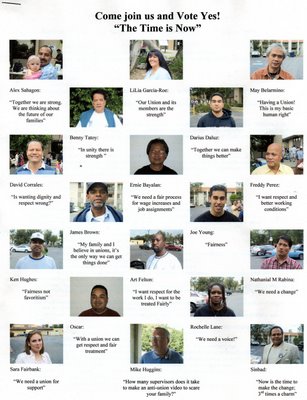the C.H.A.R.M Squad (Chemical Hazard Against Risky Management)
 Facts and Frequently Asked Questions about Unionbusting
Facts and Frequently Asked Questions about UnionbustingWhat is Unionbusting? The term unionbusting describes the planned course of action to stop workers from organizing a union or to destroy a union already in the workplace.
Who are Unionbusters?
Unionbusters are professional consultants or lawyers, who may represent a legal consortium or consulting firm. These individuals or firms advertise their ability to manipulate the labor law system and specialize in advising employers on how to thwart union organizing drives or how to decertify unions. Unionbusters usually self-identify as ‘union avoidance firms,’ ‘management consultants,’ or ‘labor consultants.’
What do Unionbusters Do?
Unionbusters offer legal services, advice and consultation, training seminars, workshops and materials for management and supervisors, and a variety of targeted anti-union propaganda for distribution to employees, including videos, posters, leaflets, flyers and giveaways. Unionbusters’ sophisticated advice, training and materials help an employer create a sense of dissension and division among employees during an organizing campaign and spread misinformation about the union before workers vote in a union representation election. Additionally, “consultants advise management on how to stall or prolong the bargaining process, almost indefinitely—bargaining to the point of boredom…”
Why Haven’t I Heard of These Firms?
Unionbusters operate under the radar intentionally. Unionbusters often provide material and instructions behind the scenes while the employer’s management and middle-management/supervisory staff carry out the actual communications with workers. In this way, the unionbuster does not deal directly with employees and, as a result, may avoid having to disclose financial reports about such activity to the U.S. Department of Labor. The unionbuster’s name or firm is not used or referenced in the anti-union materials distributed to employees, further masking the unionbuster’s involvement in orchestrating the anti-organizing campaign. More importantly, the anti-union company is rarely called on to divulge that it hired a unionbuster or reveal the specifics of such expenditures. Therefore, without a paper trail, unionbusters are hard to detect, underreported, and not in the public eye.
Who Uses Unionbusting Firms?
75 percent of employers facing a union organizing drive hire anti-union consultants.
How Successful are Unionbusters?
It is no coincidence that as the unionbusting industry has grown, the rate of union membership has declined. A unionbuster recently profiled in FORTUNE magazine had ‘won’ 32 of 35 organizing drives in 2003 for his clients. Unionbusters even go so far as advertising their rates of success. One firm, Labor Relations Institute, now boasts a money-back guarantee on its website: “If your organization purchases an LRI Guaranteed Winner Package and the union becomes certified, the Labor Relations Institute will refund the full cost of the package.”
Seven Sophisticated Unionbuster Techniques:
Read below for descriptions of common tactics and materials designed by anti-union consultants to get rid of unions.
• Supervisors as Frontline Soldiers: Supervisors, who themselves have no legally protected right to be represented by a union, are manipulated into delivering anti-union letters, speeches, and informal chats prepared by unionbusters, essentially doing the dirty work of the unionbusters and management.
• One-on-One Meetings: During organizing drives, 78 percent of workers are forced to attend closed-door or isolated meetings with supervisors. These aren’t friendly impromptu chats, but well-planned meetings to decipher employees’ feelings about the union and persuade them against the union.
• Captive Audience Meetings: So-called ‘captive audience’ meetings are held for employees during work hours to disseminate propaganda against union representation and to attempt to discredit the union. Employees are almost always required to attend, but union organizers may be intentionally disinvited. Often, the meetings are rigged so that workers who are already against the union are assigned to ask questions to sow misinformation.
• Delay: Unionbusters often attempt to delay union representation elections by legal maneuvers so they have more time to implement other tactics needed to increase tension, dissension and the employer’s chance of winning the election.
• Divide & Conquer: The unionbuster creates opportunities and crafts persuasive messages to make employees feel that there is a tense division among staff concerning the union election. They may go so far as to pit one group of employees against each other, based on race or ethnicity.
• Letters, letters, letters: A unionbuster’s specialty is hammering out materials—be it cartoons, leaflets or management correspondence—to make the case against the union. 92 percent of companies involved in organizing drives mail anti-union materials to employees’ homes.
• Love offerings: In order to convince employees that they don't need a union, unionbusters may advise clients to provide indirect bribes, like unexpected increases in wages or benefits or ‘feel good’ measures like free food and lottery tickets.


0 Comments:
Post a Comment
Subscribe to Post Comments [Atom]
<< Home